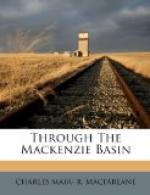The disturbance, of course, awakened the dogs, if, indeed, those wonderful creatures ever slept, and soon a prolonged howl, issuing from a thousand throats, made the racket complete. It seemed to our listening ears, for we stuck to our beds, to be a promiscuous fight, larded with imprecations in broken English, the phrase “goddam” being repeated in the most comical way. We expected to see a lot of badly bruised men in the morning, but nothing of the kind! Nobody was hurt. It proved to be a very bloodless affair, like the scrimmages of the dogs themselves, full of sound and fury signifying nothing.
Chapter VI
On The Trail To Peace River.
By the afternoon of the 12th we had finished our work at the lake, and in the evening left the scene of so much amusement, and its lively and intelligent people, not without regret. Having said good-bye to Bishop Clut and his clergy, and to the Hudson’s Bay Company’s people, and others, we passed on to Salt Creek, which we crossed at dusk, and then to the South Heart River—Otaye Sepe—where we camped for the night. This affluent of the lake has a broad but sluggish current, its grassy banks sloping gently to the water’s edge, like some Ontario river—the beau ideal of a pike stream. The Church of England mission was established here in charge of the Reverend Mr. Holmes, who had shown us every kindness during our long stay. As boats can ascend in high water to this point, the Hudson’s Bay Company had a couple of large warehouses close by, standing alone, and filled with all kinds of goods. The trail led for many miles up a long, easy ascent, through a timber country, to an upper plateau, with, after passing the Heart River, occasional small patches of prairie on the wayside. The plateau itself is the anticlinal down which the North Heart flows to Peace River, which it joins at the crossing.
The trail so far had been good, but after crossing Slippery Creek it proved to be almost a continuous mud-hole, due to its extreme narrowness and the wet weather, closely bordered, as much of it was, by dense forests. It revealed a good farming country, however, free from stones, and the soil a rich, loamy clay throughout. It was well timbered, in some places, with the finest white poplar I had yet seen. The grass was luxuriant, and the region teemed with tiger-lilies, yarrow, and the wild rose.
The Little Prairie, as it is called, is really a lovely region, in appearance resembling the Saskatchewan country. There was an old Hudson’s Bay cattle station here, at that time deserted, and here, too, we were charmed with a mirage of indescribable beauty, an enchanting portal to the mighty Peace, which we reached about mid-day on the 15th of July.
The view up the Peace River from the high prairie level is singularly beautiful, the river disclosing a series of reaches, like inland lakes, far to the west, whilst from the south comes the immense valley of the Heart, and, farther up, the Smoky River, a great tributary which drains a large extent of prairie country mixed with timber.




